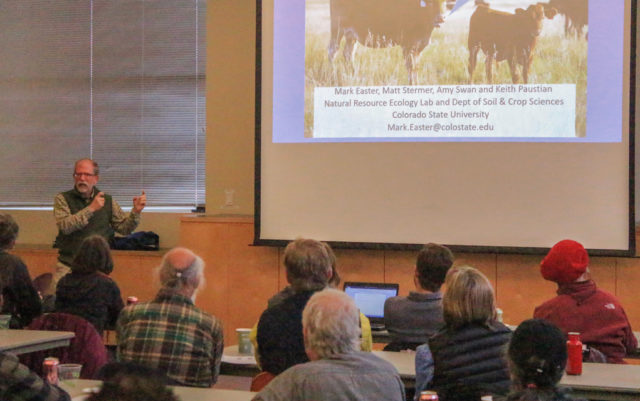
The education room of the Boulder County Recycling Center filled up quickly for the Research Conservation Advisory Board meeting. People trickled in, shaking the wet spring snow from their jackets.
It was a mixed bag: city officials, scientific researchers, agriculturalists, local residents and environmental activists. This assorted crowd had convened to discuss phase I of Boulder County and the City of Boulder’s joint carbon sequestration pilot project — an initiative that could drive a new era of sustainability along Colorado’s Front Range.
Carbon sequestration, or “carbon farming,” is a process that draws carbon dioxide from the atmosphere and stores it in land-based systems; mitigating emissions and increasing soil fertility at the same time.
Interest in this agricultural practice is blossoming throughout the U.S. and many local farmers, land owners and land managers are already using carbon farming techniques. In places like Marin County, California, large-scale projects are already underway to amplify carbon sequestration among rangelands, farmlands and forests by assembling a consortium of independent agricultural institutions.
Not wanting to be left behind the environmental curve, Boulder County and the City commissioned the Natural Resource Ecology Laboratory (NREL) of Colorado State University to conduct a feasibility study. They wanted to assess the potential for a large-scale carbon farming project in Boulder, similar to the Marin Carbon Project.
“We wanted to know, what are the best practices?” Mark Easter, a senior research associate at CSU, and the lead author of the feasibility study, told the crowd.
To answer that question, Easter explained, they went to farmers, ranchers, forest managers and compost producers around Boulder County. Through extensive interviews, surveys, feedback sessions and workshops, they began to compile a list of methods that would be most feasible, and most effective for carbon farming in the area.
As Easter explained, irrigated cropland and irrigated grass/hay/pasture systems are significantly more effective at sequestering carbon by area, than are degraded rangelands. However, what rangeland lacks in sequestration quality, it makes up for in quantity. There is so much more scruffy, uncultivated land around Boulder than there is agricultural space for carbon farming. Rangeland has notable potential simply out of sheer area.
According to the report, compost has, by far, the greatest carbon sequestration potential of the different practices examined. It diverts organic waste from landfills, improves soil fertility, increases soil carbon stocks, and allows for farmers to use less synthetic fertilizer (reducing greenhouse gas emissions generated by the production of those fertilizers). Utilizing windbreaks also offered significant carbon sequestration potential for agriculturalists, as did planting cover crops, using slow release fertilizers and reducing farmland tillage.
“It’s important to note, that none of [the recommended practices] have negative effects on crop yields,” Easter said.
Easter added that while each of these methods works individually, it’s the synergistic effect of integrating all of these components that produces the most effective outcome. Together, they make a carbon farming force to be reckoned with.
“There’s a role for everyone to play,” assured Easter. For the average citizen, the easiest, most accessible way to have a hand in this project is through compost diversion, he continued.
As for farmer cooperation, Brett KenCairn, the senior environmental planner of the City of Boulder notes that agriculturalists are going to need to see some financial advantages before carbon farming becomes standard practice. Educating farmers on the long-term economic benefits — like increased crop yields and lower fertilizer costs — is essential to encouraging their participation.
“That is the best way to get this started,” says KenCairn. Which, he admits, is going to be a complex task.
Nevertheless, as Easter mentioned after the meeting, this project already has momentum behind it. “[We didn’t expect] the extent to which a lot of farmers and ranchers are already doing some of the things that we have on the table here,” he says. “Among the farmers we’ve talked with — and we’ve talked with a lot of them — there seems to be a lot of enthusiasm and interest in this.”
That is evident within Boulder County, at places like Ollin Farms, where carbon sequestration techniques have already been in place for years. Other agriculturalists throughout the county are participating in their own ways — some even implementing holisticly planned grazing techniques — to raise Boulder’s bar of environmental stewardship.
With phase I now complete, phase II of this carbon sequestration pilot project looms on the horizon. It entails five more years of study and small-scale trials, which is no short path, to be sure. But it’s one that could have a serious impact on Boulder County’s carbon footprint.














